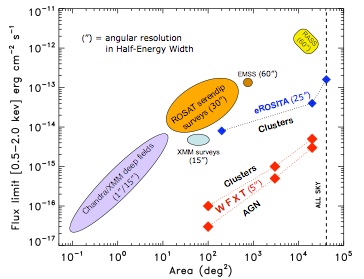
NEWS
-
•WFXT transient simulator (hosted by the DAME collaboration in Naples)
-
•WFXT Bologna Workshop talks (25-26/11/09)

The Wide Field X-Ray Telescope (WFXT) is a medium-class mission designed to be 2-orders-of-magnitude more sensitive than any previous or planned X-ray mission for large area surveys and to match in sensitivity the next generation of wide-area optical, IR and radio surveys. Using an innovative wide-field X-ray optics design, WFXT provides a field of view of 1 square degree (10x Chandra) with an angular resolution of 5′′ (Half Energy Width, HEW) nearly constant over the entire field, and a large collecting area (1 m2, >10x Chandra) over the 0.1-7 keV band. WFXT’s low-Earth orbit also minimizes the particle background. In five years of operation, WFXT will carry out three extragalactic surveys:
-
1.WIDE survey will cover most of the extragalactic sky (~20,000 deg2) at ~500 times the sensitivity, and twenty times better angular resolution of the ROSAT All Sky Survey;
-
2.MEDIUM survey will map ~3000 deg2 to deep Chandra or XMM - COSMOS sensitivity;
-
3.DEEP survey will probe ~100 deg2, or ~1000 times the area of the Chandra Deep Fields, to the deepest Chandra sensitivity.
Science:
-
1.WFXT surveys will generate a legacy astrophysical data set of ~>5×105 clusters of galaxies to z~2, >107 AGN to z > 6, and ~105 normal and starburst galaxies at z<~1
-
2.The WFXT mission is scientifically broad, as the survey data will:
-
•provide a description of the cosmic evolution and cycle of baryons
-
•map the large scale structure of the Universe
-
•constrain and test cosmological models and fundamental physics (e.g. the nature of Dark Matter, Dark Energy and gravity)
-
•determine the black hole accretion history to early epochs and its intimate link with galaxy formation
-
•provide an unprecedented view of nearby galaxies including our own.
-
3.WFXT is not only a path finder for other missions, its large collecting area allows direct physical characterization of a large fraction of sources (AGN and Clusters) via X-ray spectroscopy with no need of follow-up observations. Synergy with other missions further enhances its scientific potential and breadth.
-
4.Like the Sloan Digital Sky Survey, all WFXT data will become public through a series of annual data releases that will constitute a vast scientific legacy for decades.
Resources:
-
European WFXT site (P. Rosati)
-
US WFXT website at JHU
-
WFXT transient simulator (hosted by the DAME collaboration in Naples)
-
WFXT data simulator at ASDC
-
WFXT Bologna Workshop talks (25-26/11/09)
-
White Papers submitted to the Decadal Survey 2009 (ESO WFXT site)


